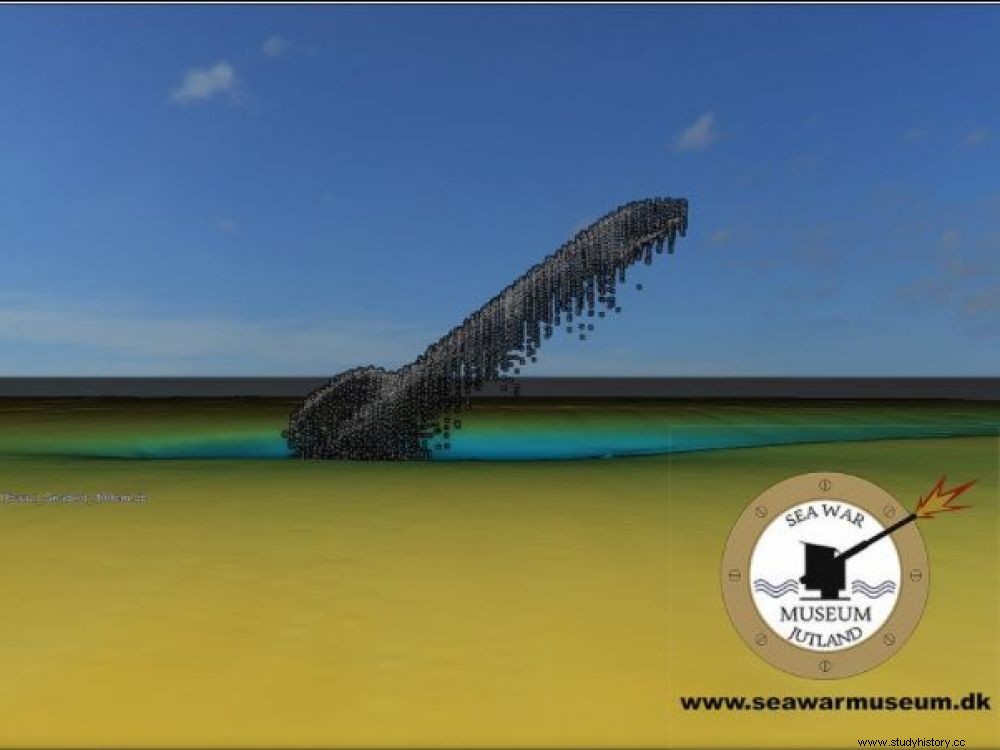A Danish maritime expedition has discovered a missing U-boat since the end of World War II, ending a 73-year-old mystery.

Computer-generated image of Nazi submarine U-3523 found in April 2018 off the coast of Denmark by researchers at Sea War Museum Jutland.
It is a submarine planted in the ocean floor, the stern in the air, erected at 45 degrees, that the explorers of the Sea War Museum Jutland (Jutland Sea War Museum), in Thyboron, just detected in northern Denmark. At the beginning of April 2018, the German U-Boat, which disappeared at the end of the Second World War, was indeed spotted in the Strait of Skagerrak, about fifteen kilometers northeast of Skagen, between Norway, Sweden and the Jutland Peninsula (Denmark).
Prow sunk into the ocean floor, only 20m of the stern of the U-3523 submarine is currently visible. © Saewarmuseum.dk
The disappearance of the Nazi submarine had given rise to many rumors
According to information provided by the Danish museum, taken up by the British daily newspaper The Independent , the submarine had vanished into the wild one day after the surrender of Nazi forces in Denmark (May 5, 1945), and only two days before the official end of the war in Europe (May 8, 1945), giving rise to many rumours. The most important being his escape with Nazi leaders on board, fueled by the inability to identify the wreckage. But 73 years later, a whole different story is unfolding. This submarine, which was thought to have managed to escape to South America, was in fact hit by a British bomber on May 6, 1945, as was reported at the time... But what a position error of 9 nautical miles (16.6 km) did not then allow localization. Seven decades will therefore have been necessary to find any trace of it. It was therefore at a depth of 123 m that the submarine went to complete its race, carrying its 58 crew members forever.

Digital reconstruction of the possible position of the submarine U-3523. ©Saewarmuseum.dk
Radar images taken from the research vessel Vina allowed to present the wreck of U-3523, building type XXI, the most advanced generation of submarines of the time. He would indeed have been able to make a transatlantic crossing without having to resurface. The streamlined shape of her reinforced hull allowed her to reach a diving speed of 17 to 18 knots, a record it seems. Above all, its batteries allowed it to last several days in deep diving.
Autonomy acquired thanks to the German invention of the snorkel. "It was a kind of giant snorkel which, flush with the surface, allowed the submarine to recharge its batteries using its diesel engines, while renewing its oxygen supplies by remaining between 3m and 6m below the surface of the water “Summarizes Richard Alain, one of the best specialists in the history of submersibles, joined by Sciences et Avenir . Once the batteries are charged and the snorkel cut, the building plunged again. Although the Nazis tried to destroy all their submarines XXI so as not to see these technological advances fall into the hands of the victors, after the war the United States, the Soviet Union, France and Great Britain would have succeeded to grab a few.

German submarine U-505 captured by the Allies in the Atlantic in May 1945. © Collection Bernard Crochet /AFP
Only one Type XXI submersible is believed to remain today, on display in the harbor at the Maritime Museum in Bremerhaven, Germany. As for the German submarines having reached South America, all was not all fables. In 1945, two of them managed to reach Argentina, and the port of Mar del Plata:a U-530 on July 10, and a U-977 on July 17. Some myths are also based on realities …
